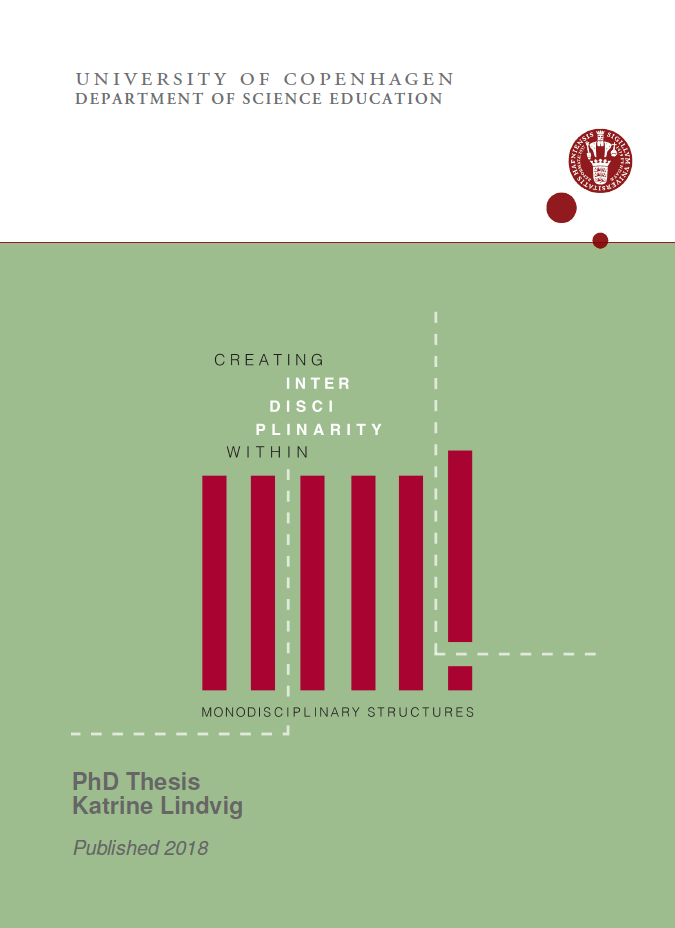Nr. 52/2018 Creating Interdisciplinarity within Mono-disciplinary Structures
Submitted September 2017.
Abstract
This PhD thesis is the result of a PhD project conducted as part of the development project ‘Interdisciplinary education at UCPH’. Whereas the overall aim for the development project was to improve and support interdisciplinary teaching and learning at the University of Copenhagen (UCPH), the objectives of the PhD project were to explore the linkages between interdisciplinary research and education, and to follow the concrete development and execution of interdisciplinary educational activities. In order to meet these objectives, an extensive literature study and an ethnographic fieldwork were conducted.
In the literature study, a systematic search in nine online databases and subsequent analysis of the hits resulted in a review of 60 peer-reviewed international papers on interdisciplinary teaching practices. The fieldwork included observations and interviews across five interdisciplinary research projects in the Excellence Programme for Interdisciplinary Research at UCPH, following educational activities at bachelor’s, Master’s and PhD level. The empirical material was analysed and the findings described in four papers in the present thesis. The findings are as follows:
While interdisciplinary teaching is increasingly popular in higher education, very few empirical accounts have found their way to the peer-reviewed literature. The limited outlet of cases and empirical accounts affect the way, interdisciplinary teaching practices are perceived and practiced. Although ‘grey’ literature may offer more accounts of concrete examples of interdisciplinary teaching practices, the absence of these in the peer-reviewed literature limits the access to these experiences by scholars and teachers from other communities.
The fieldwork mapped a range of one-off interdisciplinary educational activities taking placed primarily as elective courses at the master’s and PhD levels. In addition to these activities, there were also multiple unreported student-driven activities, linked to the research projects and taking place in the interstices of the mono-disciplinary structures.
PhD students affiliated with the research projects were included in the study as they were also examples of interdisciplinary educational activities. Based on interviews with 25 PhD students the analysis addressed a multiplicity of expectations pointed towards the PhD students. The analysis highlighted students navigating expectations raised by the Principal Investigators of the interdisciplinary projects and by the mono-disciplinary structures of the university, by limiting the scope for experimentation and detours. The PhD students were thus at the same time seen as those enacting the interdisciplinarity of the projects and as students who were to be assessed within a mono-disciplinary contexts.
Finally, an analysis of the official documents at programme level and of local interdisciplinary efforts at project level showed that the lack of definitions, of set criteria and of aims for the interdisciplinary activities in the programme had visible effects on the local practices of interdisciplinarity.
These findings point towards wide discrepancies in the use of the term interdisciplinarity, which have repercussions for the practices and incentives of creating interdisciplinary education, research and collaboration. Overall, the thesis show that interdisciplinary teaching and learning practices has to engage in a continuous balancing of different dynamics and interests. One important consequence of this is that the important interdisciplinary learning experiences of students occur in the interstices between mono-disciplinary structures and practices and that a way of supporting the development of interdisciplinary competences among students would be to maintain the students’ opportunities of acting within these interstices. Another finding of the research presented here is that although the discussion of how to understand and define interdisciplinarity is indeed important, insisting on particular fixed definitions may, at the end of the day, be detrimental to the interdisciplinary practices.
Buy printed version at lulu.com
Download pdf-version - "Creating Interdisciplinarity within Mono-disciplinary Structures" [6.0Mb]

